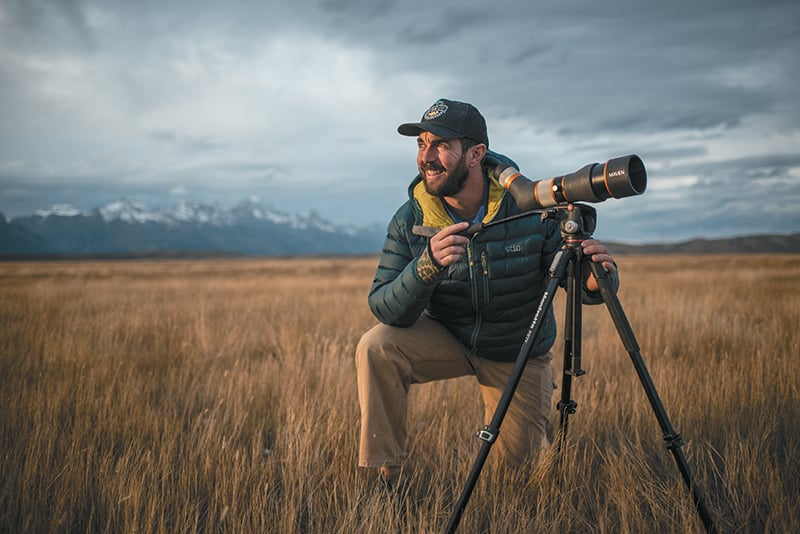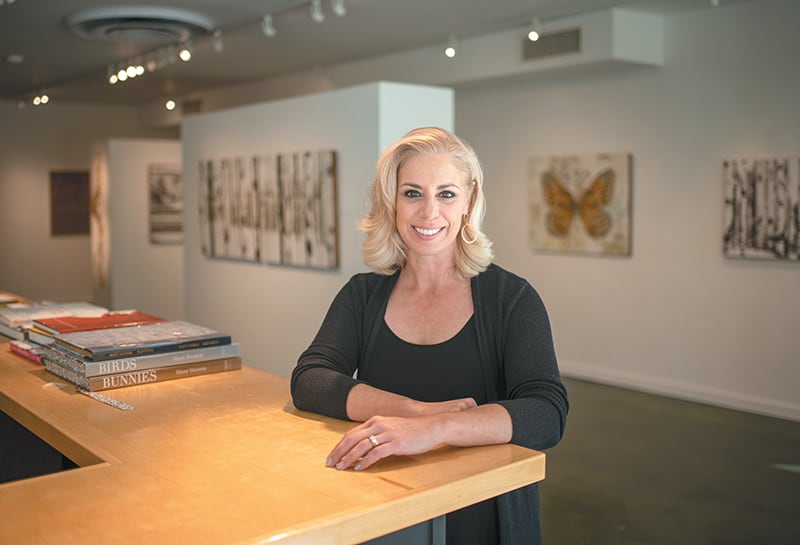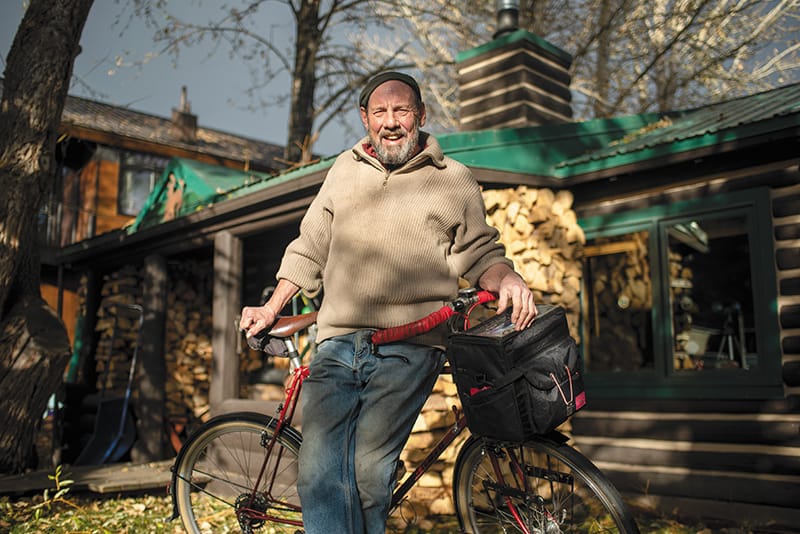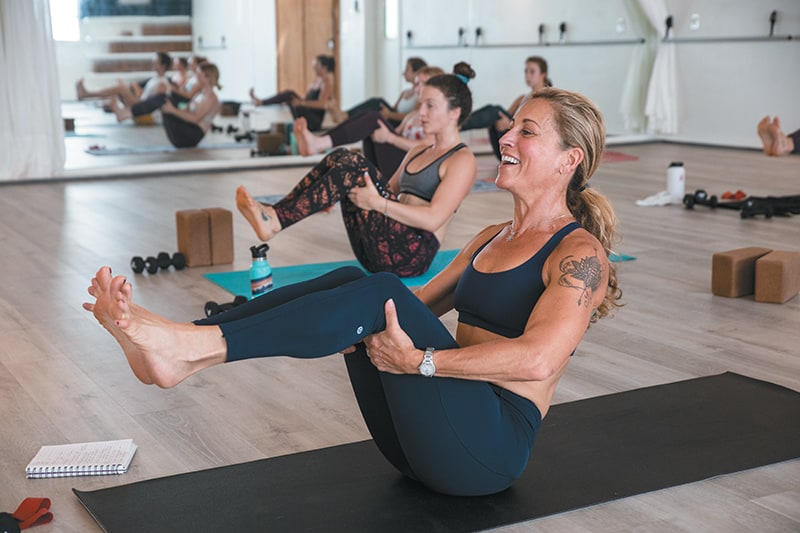Read The
Current Issue
Sense of Place
Meet seven locals who show that the reasons for moving here are as diverse as the area’s wildlife.
By Dina Mishev
NEESHA ZOLLINGER
WHY: BEAUTY, ENERGY, AND ARTS
WHEN: 1999

Photo by Bradly J. Boner
ARRIVING IN JACKSON in 1999 for an audition with Contemporary Dance Wyoming, Neesha Zollinger says, “It was the most magical experience I’ve ever had. I just felt an energy and I felt in the flow. It was a totally unexpected connection with this place.” Six weeks after her audition Zollinger moved to Jackson from Utah, where she was working as a soil scientist and doing some dancing. She was one of the founding members of Contemporary Dance Wyoming. “I love the outdoors and wanted to be creative and dance and have the benefits of nature,” she says. “But I don’t think I ever really thought it could happen.”
Before coming to Jackson for her audition, Zollinger had been here once before. “I was in fifth grade and have no memory of it,” she says. “I had always lived in small towns though, so that part of Jackson didn’t surprise me.”
In 2005, Zollinger took over a small yoga studio, renamed it Akasha Yoga, and grew it. Akasha is now one of the bigger yoga studios in the valley; Zollinger still owns it and teaches there. Her daughter Stella was born here in 2012. As much a part of the community Zollinger is though, she confesses to “sometimes feeling like an alien. So many times people just look at me like I’m such an oddball because I can barely ski. It is a skill set I didn’t grow up doing. People are like, ‘What are you doing here?’ They just don’t get it; they’re confused that there are other things that people are really passionate about here.”
Despite these moments of alien-ness, Zollinger says she never got close to moving away from Jackson. “There are definitely times where I’m like, ‘This climate is harsh.’ But this place is so full of opportunities and I love the community and the people. Part of this comes from the affluence here: People are very interesting and doing amazing things. Jackson Hole is this nexus of incredible people with great ideas and making things happen. I love being in that energy. It feels very alive.”
TAYLOR PHILLIPS
WHY: WILDLIFE AND PUBLIC LANDS
WHEN: 2002

Photo by Bradly J. Boner
TAYLOR PHILLIPS STUDIED the Greater Yellowstone Ecosystem while earning his undergraduate degree in environmental studies/environmental philosophy at Eckerd College in Florida. Still, it wasn’t until one spring break when he stayed on campus to earn some money and found an Ansel Adams photo of the Tetons and Snake River that he thought about actually traveling here from the East Coast. “I didn’t know where or what the photo was,” Phillips says. “I just thought it was pretty.” His ignorance about the image, which he had hung in his dorm room, quickly ended. While Phillips had worked over spring break, a friend went skiing in Jackson. “He saw the photo and was like, ‘I was just in Jackson and it’s awesome!’ I was like, ‘Who goes to Wyoming?’” Phillips says. “But my interest was sparked.”
As his graduation neared, Phillips’s parents wanted to know what he was going to do with his degree. “The Tetons were on my radar,” he says. “There was the National Park Service, Forest Service, and guide services, so for my major, it seemed a good place to land.” Shortly after graduation Phillips drove to Jackson, parked his van near Miller Park, and spent the night there. “I’m pretty sure that was illegal,” he says.
Phillips’s guess that there would be plenty of jobs for him related to his major was correct, and he quickly got a job running a field research station for Teton Science Schools. But it wasn’t just about the availability of jobs. “The landscape and wildlife here [were] incredible,” he says.
With the exception of eight months during which he hiked the Appalachian Trail and another couple of months when he paddled the Yukon River, Phillips has been in Jackson Hole since. He continued to work for Teton Science Schools and eventually began guiding some of their wildlife expeditions. He also worked as a hiking guide. In 2008 he founded Jackson Hole Eco Tour Adventures. “I wanted to make it a career and not a job,” he says. The first three years Phillips did everything himself, from marketing to booking and guiding. Now Eco Tour Adventures has a staff of about 20.
“It feels a little like I’ve come full circle,” Phillips says. “I wrote my thesis at Eckerd on ecotourism and came out here because of the landscapes and wildlife. Now I’m helping visitors have a more meaningful experience with these while they are here.”
ESTELA TORRES
WHY: CAME WITH A BOYFRIEND, STAYED FOR THE BEAUTY
WHEN: 1981

Photo by Bradly J. Boner
ESTELA TORRES REMEMBERS her dad asking if Wyoming was a state when she moved to Jackson in 1981 with her then-boyfriend. “I had heard about Yellowstone, but, growing up in Joliet [Illinois], never really thought I’d visit the area,” she says. “It was an accident that we moved here.” Her boyfriend, who was a law clerk, wanted to move to Colorado, but “because of bar exams and such we settled here,” Torres says. “I was immediately enthralled by the beauty of the place, but slowly I began to feel, ‘Wow, there are no Mexicans here.’” Torres was born in the U.S., as were her parents, she explains. “But they were raised in northern Mexico,” she says. “I was raised like a Mexican but here in the U.S.” She says she missed being able to speak Spanish after moving to Jackson.
While there was no one for Torres to speak Spanish with, she did have a job she loved. She worked as a paralegal at the Ski Corp (now Jackson Hole Mountain Resort, or JHMR) and worked directly with Ski Corp co-founder Paul McCollister. “Paul was one of my best bosses ever,” she says. “I came from the slums of Chicago and to be invited to the home of the founder of the Ski Corp—that really turned things around for me.” Torres stayed at Ski Corp for about 10 years. After having two daughters—Christina, now 34, and Jessica, now 31—she returned to the Ski Corp and worked seasonally. “I was pretty happy, but did honestly feel there was a void because there were no Latinos here,” she says. “But then they started coming in the 1990s and that made me feel more joy.”
Today it is difficult to imagine Jackson Hole without its Latino population. In 1990, Latinos made up less than 2 percent of Teton County’s population; by 2018 that had grown to 12 percent. (In the Town of Jackson itself, about 25 percent of the population is Latino.) Torres says she now has more Latino culture in her life than her sisters “who live in bigger cities where there are huge Latino communities. Because Jackson is so small, it’s so easy to know what’s going on and to be involved.”
If someone had told Torres in the early 1990s that in 2019 she’d be working full-time in Jackson at a nonprofit (One22) whose mission was to help immigrants to the area facing health, financial, and cultural challenges, and speaking Spanish every day, she says she would not have believed them. “I don’t know which part of that would have been most unbelievable—that I’d still be in Jackson or that there was a Latino community in Jackson Hole,” Torres says. “My family still makes fun of me for living in what they call a ‘one-horse town.’ But my sisters don’t really even speak Spanish anymore.”
MARIAM DIEHL
WHY: HORSES AND TO EXPERIENCE SOMETHING COMPLETELY DIFFERENT
WHEN: 2002

Photo by Bradly J. Boner
SITTING IN A plane on a dirt runway in British Columbia, Mariam Alaskari (now Diehl) was crying. It was the summer of 2001 and she had spent the previous two weeks horseback riding in the Chilcotin Mountains. Now vacation was over and Diehl was headed back to New York City, where she was born, raised, went to college and graduate school, and had a career doing development work for some of the city’s larger nonprofits. “I liked New York, but decided I needed to change things and make my life more like the horseback riding vacations I took every summer,” she says. Diehl returned home and immediately began researching places. “I was looking for a small town, big mountains, horses, and not Aspen or Vail or someplace I would find Prada or Chanel. And I didn’t want rolling hills. I wanted it to be vastly different from where I came from.”
Diehl had never before been to Jackson, but it was on her list from the beginning. “The more I read the newspapers online, the more it seemed perfect,” she says. “I started applying for jobs—everything from a Hines Goldsmith salesperson to a kennel cleaner.” She moved to Jackson in January 2002 and started doing development for the campaign that worked to build the Center for the Arts. Soon she got more directly involved with the valley’s art scene; she took a position as director of Meyer Gallery. Within three years Diehl bought that gallery. “The more I worked in the art industry, I realized I loved it and was passionate about it,” she says. “And it seemed Jackson’s art scene was ready to evolve.”
In the fall of 2005 about seven galleries, including Diehl’s, came together and created ContemporaryArtJacksonHole, an event within the annual Fall Arts Festival. “I think that group of galleries was at the forefront of pushing Jackson forward into contemporary art,” says Diehl, who renamed Meyer Gallery Diehl Gallery in 2008.
While Diehl is likely one of the few women in Jackson to wear heels on an almost-daily basis—wandering into Diehl Gallery is interesting not only to see art by the artists Diehl represents, but also to see what the owner is wearing—she is now as comfortable in Sorels, ski boots, and waders as she is in four-inch stilettos. She and her husband Scott—“our second date was fly fishing,” she says—have a son in sixth grade. “I’m raising a true Jackson boy,” Diehl says. “He fishes, bikes, hikes, skis, hunts, snowboards, and rides horses.” Diehl herself cooks and eats the game meat Scott hunts, Nordic and downhill skis, fly fishes, and mountain bikes. And she rides her horse Oberon as much as possible. This past spring she and Oberon went through training for the Jackson Police Department’s Citizens Mounted Unit.
“I knew when I got off the plane the first time that I was right about my decision, and that Jackson was going to be home,” Diehl says. “And it is.”
KEITH BENEFIEL
WHY: HAPPENSTANCE
WHEN: 1974

Photo by Bradly J. Boner
INDIANAPOLIS, INDIANA NATIVE Keith Benefiel grew up on a bicycle. “My father was killed a few months before I was born and my mother didn’t have a lot of money. I got to grow up without a car,” he says. It may sound a little crazy that, in April 1974, Keith and his wife at the time attached trailers to their bikes and rode west from Indiana to Lander, Wyoming. But it wasn’t crazy for this couple. Their dog, Little Bear, a “big old lab/shepherd mix, ran most of the way,” Benefiel says.
Arriving in Lander, however, “The town was in an economic depression,” Benefiel says. “The iron mine had [recently] closed. Winter was just getting going, so we headed to the only town in Wyoming with a winter economy, Jackson.” Full-on winter hadn’t quite arrived yet, so the Benefiels were able to live at the Jenny Lake campground for three weeks. “It was just a great adventure,” Benefiel says. “I’d hitch into town looking for a place to rent.” He found a “little upstairs roof apartment where you could only stand up in the hallway in the middle; there were dormers at the sink and toilet.”
In 1975, Benefiel bought Teton Cyclery, the only bike shop in town, which had been founded in the early ’70s, and owned and ran it for the next 20 years. In winter, he’d ski on Teton Pass. “We never went up Glory, that was too damn dangerous. We waited until corn,” he says. A friend showed Benefiel a ridge on the south side that wasn’t skied often. “Skiers stayed away from it because it turns into trees, but [my friend] showed me it went farther. It became my personal run.” Today that ridge is known as “KB Ridge,” and Benefiel says the “KB” stands not for his initials, but for “killer bud.”
In the late ’70s, his wife left the valley to go back to school, leaving Benefiel a single dad to their toddler daughter. He says, “For me, it’s paradise here. I couldn’t imagine ever leaving.”
Benefiel was one of the founding members of the Teton County Search & Rescue Team. “When we started it up, it was just a phone tree,” he says. “They’d call me and I’d call people who were competent and unemployed.” While Benefiel did buy a car—his first—after his daughter was born, bikes have remained his primary mode of transportation. He helped his friend Tim Young get the pathways project going. “I never thought [pathways] would happen, and that we’d have to settle for wider shoulders, but Tim put his entire life into it and built one of the premier pathways [systems] in the country.”
Forty-five years after arriving, Benefiel, who has lived in a historic log cabin in Wilson with his second wife, Diane, since 1981, knows Jackson Hole has changed, but not completely. “For what I came here for, it hasn’t changed,” he says. “I can walk across the street [from our cabin] and the next time I see pavement, I’ll be in West Yellowstone [Montana]. Go up Cache Creek and the next pavement is Lander or South Pass. And Teton Pass—that’s still the other room of our house. I didn’t come here for the people, so they can’t chase me out.”
CHAD CARLSON
WHY: QUALITY OF LIFE/TO RAISE KIDS
WHEN: 2016

Photo by Bradly J. Boner
CHAD CARLSON AND Ed Westerman renovated a 5,000-square-foot house in the valley with the idea that it’d be a second home. The couple lived and worked in San Francisco. “We thought that maybe one day [the house here] could be a half-time home,” Carlson says. But then they learned their surrogate was pregnant. With twins.
They reconsidered their living situation in San Francisco: a 1,200-square-foot house high on a hill in Noe Valley. They also reconsidered the city itself. “The city had changed so much; it wasn’t the city we had moved to. It was just more, more, more, more, more. I didn’t want to raise my kids and tell them not to pick up a heroin needle on the sidewalk or to stroll past human fecal matter. And I was burned out at work.” The more the couple thought about it, the more obvious moving to Jackson seemed. “We had this great big, recently remodeled house sitting empty in Wyoming. We decided we’d go to Jackson for a while and see how it went.”
The twins, Ethan and Violet, are now three, and, as far as Jackson goes, Carlson says, “I’ve since fallen madly in love.” Not that it was easy. “When we first got here, I didn’t know anyone and I was a new parent who had just quit his job,” he says. “I’d cut every safety line in my life and just plopped down in the middle of Wyoming.” But then small-town life started happening. Carlson was introduced to a Wilson mom group and learned of several other couples that had recently had multiples. “It was just this weird little confluence that wouldn’t have happened anywhere else but in a small town—there were eight of us that had twins born within eight to nine months of each other.” A Facebook page Carlson founded, Teton Twins–Jackson Hole Parents of Multiples, now includes about 25 families. Carlson recently took a position as CMO at the local start-up Happy Active Family.
Carlson’s love of Jackson doesn’t stem solely from the community of parents he’s gotten to know. “Within the entire community there seems to be a consistent desire to elevate what is expected of a small town in Wyoming. Everybody who lives here has the same sense of wanting to be part of a place that is so special. We could pick up and move to lots of places that are equally beautiful and have greater opportunities for careers, but there is something magical here that makes you say, ‘Well, I’m going to figure it out so I can be a part of this very unique place.’ Our quality of life here is just so opposite [of] what it had become in San Francisco.”
NIKI SUE MUELLER
WHY: THE MOUNTAINS
WHEN: 1993

Photo by Kathryn Ziesig
THERE ARE MORE direct ways to get to Oregon from Ft. Collins, Colorado, than through Jackson. But, because a college friend of Niki Sue Mueller’s lived in Jackson, when Mueller and friend Bobbi Reyes were driving from Colorado to Oregon for a Jerry Garcia Band concert in July 1993, they made a point of stopping here. “We knew we had a free place to stay,” Mueller says. The two women loved the town and mountains so much they stopped again on their way home. “Instead of staying overnight we stayed for two weeks, though,” Mueller says. Less than a month later, Mueller and Reyes said “good-bye” to Ft. Collins and moved to Jackson.
“We didn’t have any long-term plans. But I did see myself in a mountain town,” says Mueller, who had graduated from Colorado State University with a degree in psychology and sociology the spring before coming to Jackson. “I had thought that mountain town would be Durango [Colorado], but something about the mountains here—about being in the mountains here—captivated me. I don’t even know what it was.”
Mueller got a job at Hoback Sports and she thinks she was the store’s first female employee. “There were not many women here at the time,” she says. But “everyone was so kind and welcoming.” Still, at the end of her first year in the valley, Mueller took a two-month road trip with the purpose of finding a new place to live. “I went across the country from the Pacific Northwest to the bottom of California, [then to] Sedona [Arizona] and the East Coast. The road trip ended with me realizing there was no better place for me than Jackson. I had moved to Jackson for the mountains, but they came with this amazing community. I was surrounded by such wonderful people. I’m definitely a family person and it felt very family-like.”
Back in Jackson, Mueller returned to her job at Hoback Sports, which at the time was where the Harley-Davidson shop is now. That winter she skied hard; within several years she was following around some of the Jackson Hole Air Force skiers. “They were just like the rest of the community—so kind and welcoming,” she says. “I feel so lucky that I was embraced by those guys, and they showed me the ropes.”
Mueller began working in social services, in addition to working in bike shops, and also started teaching yoga, which she had begun practicing in 1994. She got married and had kids (a daughter in 2009 and a son in 2012) that she loves raising in Jackson. “My children have opportunities here that I didn’t have growing up on the East Coast near the city,” she says. “The education they’re getting is amazing, they get to go skiing after school, and our family is part of such a tight community. I came for the mountains, but I’m still here for the people. This community is the most special I’ve ever felt.” JH




